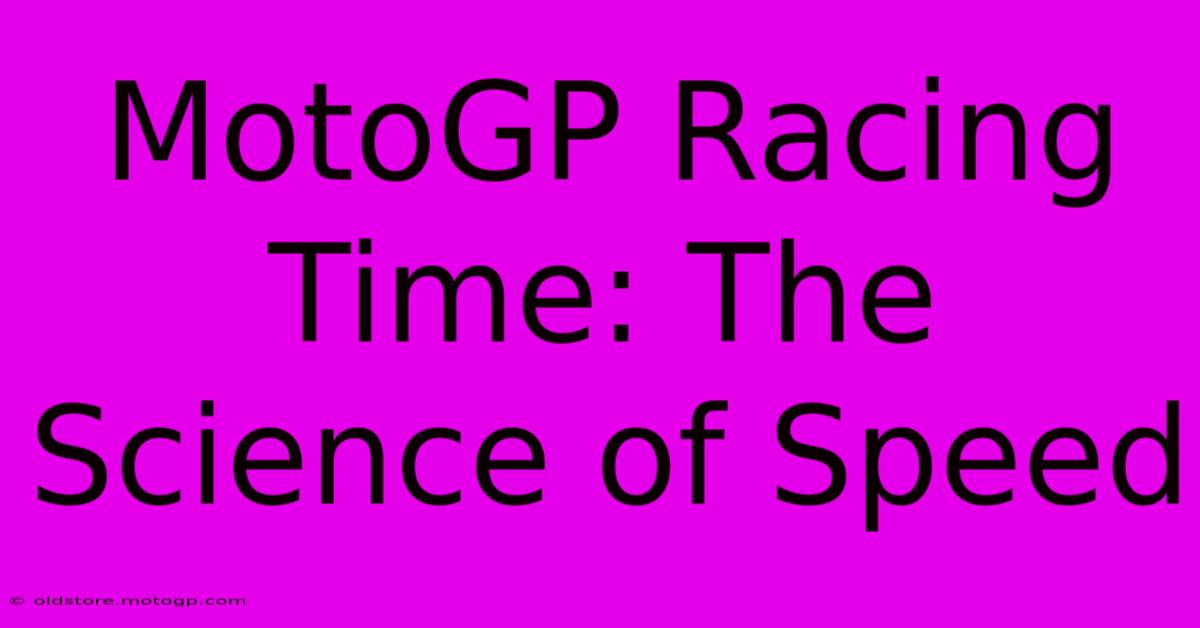MotoGP Racing Time: The Science Of Speed

Table of Contents
MotoGP Racing Time: The Science of Speed
MotoGP racing isn't just about speed; it's a meticulously orchestrated dance between rider skill, machine performance, and the relentless pursuit of shaving milliseconds off lap times. This article delves into the science behind those breathtaking speeds, exploring the key elements contributing to a MotoGP rider's success.
The Physics of Speed: More Than Just Horsepower
While horsepower is undeniably crucial, MotoGP speed is a complex interplay of several factors:
1. Aerodynamics: Cheating the Wind
Modern MotoGP machines are marvels of aerodynamic engineering. Aerodynamic wings, streamlined fairings, and carefully designed bodywork all work in concert to reduce drag and increase downforce. Downforce keeps the tires glued to the track at high speeds, allowing for later braking and faster cornering. The constant evolution of these aerodynamic elements is a testament to the pursuit of marginal gains. Teams invest heavily in wind tunnel testing and Computational Fluid Dynamics (CFD) simulations to optimize every detail.
2. Tire Technology: The Grip Factor
The connection between the bike and the track is paramount. MotoGP tires are high-performance marvels, meticulously designed to provide maximum grip in various conditions. Tire compounds, tread patterns, and pressure are carefully selected depending on track temperature and conditions. The grip provided by these tires is what allows riders to push the limits of acceleration and cornering speeds. Even minor variations in tire performance can significantly impact lap times.
3. Engine Performance: The Heart of the Beast
The MotoGP engine is a finely-tuned masterpiece of engineering. These sophisticated powerplants generate enormous horsepower, propelling the bikes to incredible speeds on the straights. Engine mapping, exhaust systems, and internal combustion technology are constantly being refined to extract every ounce of performance. The quest for more horsepower without sacrificing reliability is a relentless challenge for engine engineers.
4. Chassis and Suspension: Handling the Beast
The chassis and suspension system are responsible for how the bike handles. A well-balanced and responsive machine allows riders to navigate corners with precision and speed. Suspension settings, chassis geometry, and weight distribution are all meticulously adjusted to suit the specific characteristics of each track. The ability to fine-tune these elements is crucial for maximizing cornering speed and overall lap time.
5. Rider Skill: The Human Factor
Even with the most advanced technology, rider skill remains the ultimate determinant of success. MotoGP riders possess exceptional physical fitness, reflexes, and racecraft. Braking techniques, cornering lines, and race strategy all contribute to a rider's ability to consistently achieve fast lap times. Years of training and experience are necessary to master the demanding skills required at this level of competition.
Beyond the Technical: The Pursuit of Perfection
The pursuit of speed in MotoGP is a constant battle against the clock. Teams employ sophisticated data analysis tools to track every aspect of performance, identifying areas for improvement. Even the smallest adjustments – a minor tweak to the suspension, a refined braking technique – can significantly impact lap times. The relentless quest for marginal gains is what separates the winners from the rest.
Keywords: MotoGP, racing, speed, aerodynamics, tires, engine, chassis, suspension, rider skill, lap times, technology, performance, physics, downforce, horsepower, cornering, braking, data analysis.
Conclusion: A Symphony of Science and Skill
MotoGP racing represents the pinnacle of motorcycle racing technology and rider skill. The pursuit of speed is a complex interplay of sophisticated engineering, meticulous preparation, and exceptional talent. By understanding the science behind those incredible speeds, we can better appreciate the thrilling spectacle of MotoGP racing and the dedication of the individuals who make it possible.

Thank you for visiting our website wich cover about MotoGP Racing Time: The Science Of Speed. We hope the information provided has been useful to you. Feel free to contact us if you have any questions or need further assistance. See you next time and dont miss to bookmark.
Featured Posts
-
Cheap Formula 1 Austin Parking Does It Exist
Feb 20, 2025
-
Formula 1 Shuttle The Gold Standard
Feb 20, 2025
-
The Environmental Impact Of Motorcycle Racing Exploring Sustainable Practices
Feb 20, 2025
-
Cota Merchandise The Perfect Gift For Any Occasion
Feb 20, 2025
-
Cota Grandstands Your Ticket To An Epic Race
Feb 20, 2025
